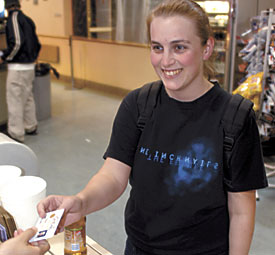 |
|
CHRIS CODUTO/Arizona Daily Wildcat
|
Freshman Rebecca Goldstein buys a sandwich with her CatCard at On Deck Deli yesterday. She is one of many students whose spending habits do not fit into the stereotypical collegiate model.
|
|
By Orli Ben-Dor
Arizona Daily Wildcat
Tuesday February 18, 2003
Has ramen soup seen its expiration date? The spendthrift habits of students
Once upon a time, college living was closely associated with ramen noodle dinners and shoestring budgets. For many, college life still means balancing jobs and seeking happy hour specials, sale racks, and show-your-CatCard deals.
But a new demographic now trades a cup o' soup for a $5 cup o' joe. According to director of student financial aid John Nametz, the UA experiences a "reciprocal" tuition and income phenomenon. That is, because of tuition levels and grant
eligibility, it becomes more economical for students coming from non-needy or less-needy financial backgrounds to enroll at the UA rather than students coming from needy backgrounds. Nametz said that for some
students from the Midwest in particular, going in-state would cost significantly more than coming all the way to Arizona for school.
So where does all the cash go for these UA students? Are they penny-pinching, loading up on ramen noodle packages at five for a dollar? Are they denying themselves shopping sprees, meals out of the house and vacation getaways?
Not quite. Jackie Seidelman, a retailing and consumer sciences freshman from Florida, empties her wallet by filling shopping bags and empty stomachs.
"We eat out five out of seven days a week. We go out Thursday night, usually Gentle Ben's, then stay in Friday or go see a movie ÷ then go out again to some random bar on Saturday night ÷ usually doing karaoke," she explained.
Eating out won't necessarily mean Los Betos bargain burritos, either. At Frog and Firkin, a pub-inspired restaurant on East University Boulevard where
students flock for outdoor seating and eats and drinks, most customers won't just stick with the basic burger, pay and leave.
"A couple people will spend an average of $20 to $25 on lunch or dinner. On a Friday or Saturday night, though, a group of people might spend $100. Actually, I saw a group drop $600 once," said Steve Luna, an undecided sophomore and server at Frog and Firkin.
The buck ÷ so to speak ÷ doesn't stop on Friday night dinner with friends, though. Spending a hundred bucks on clothes and other accessories seems, for this demographic in particular, just as routine as Seidelman's going-out schedule.
"I go shopping once every two weeks, usually to Zo‘ or Urban (Outfitters) because they're within walking distance. I would shop at Butz if I had a car," Seidelman said.
Zo‘, an upscale clothing store on North Fourth Avenue carries up-and-coming designer brands in addition to well-known designer lines like Juicy Couture, whose jeans usually cost upward of $100. On any given day, one can probably spot a student sporting a funky Urban Outfitters bag or holding a freshly purchased item. Urban Outfitters holds the reputation of being the store of the college town, first popping up in Philadelphia, New York City and Boston, because of its trendy, funky items ranging from both men's and women's clothing to shower curtains and sake sets.
The last store Seidelman mentioned, Butz, has a close relationship with UA and, in particular, UA Greek life.
"We do a lot of work with sororities, helping them with fashion shows," owner Julie Penny said. "The U of A loves Butz."
Located in the St. Phillip's Plaza at North Campbell Avenue and East River Road, the long drive doesn't discourage too many students from spending the big bucks there.
"It's cute ÷ they drive their BMWs and Ranger Rovers and leave with bagfuls of clothes. On an average visit, it could be anywhere from $150 to ÷ the sky's the limit," Penny said.
Though Seidelman belongs to the Alpha Epsilon Phi sorority and Butz does do a lot of business with the sororities, big spending is not limited to students donning Greek-lettered sweatshirts.
"We find that a lot of our clients come from New York, Chicago, L.A. and other big cities and they're used to forward fashion. We never advertise, but they find us their freshman year," Penny added.
As students stock up on outfits throughout the semester during shopping sprees, one week in mid-March lends itself to shedding clothes rather than accumulating them: spring break.
STA Travel, a student travel agency, busies itself with booking spring break trips for both the frugal-minded and extravagant. Julie Betz, the branch manager of the STA Travel outlet located in the Student Union Memorial Center, calculated that they've already booked 300 ÷ 400 spring break reservations for students in their branch alone. This year, she added, many companies have made cheaper options available to spring breakers like bus trips to Rocky Point, cutting out expensive airfare fees. Still, students have shown greater interest in exploring more out-of-the-ordinary locales. With Mexico just a hop, skip and a jump away, students expand their spring break options, which also means dishing out extra cash to make it happen.
"People down here may want something more interesting, like Europe. We even have students going to more exotic places like Central America," Betz said. She estimated that most international trips cost around $1,000 for airfare and hotel costs alone.
During a time when the United States struggles with a trillion dollar deficit and Arizona's financial situation threatens the livelihood of many departments here on campus, a highly visible group of students adopt a spendthrift lifestyle. If Frog and Firkin splurges and Butz binges indeed result from what Nametz calls the "reciprocal" response, a tuition hike might result in a ramen noodle comeback.
Nametz explained that one can attribute some reasoning behind the pending tuition changes to President Likins' hope to smooth out the jagged disparity intensifying among the high-need and low-need students under the current tuition rate and grant system.


